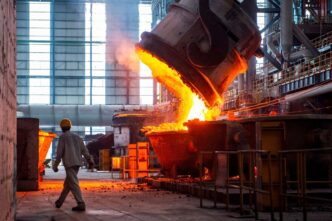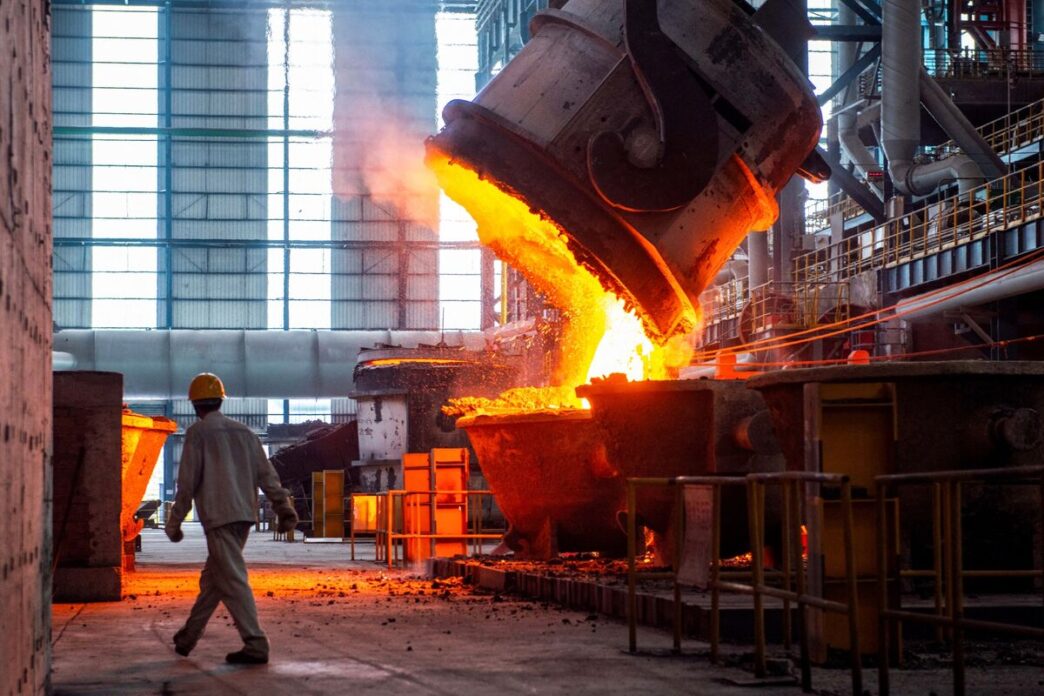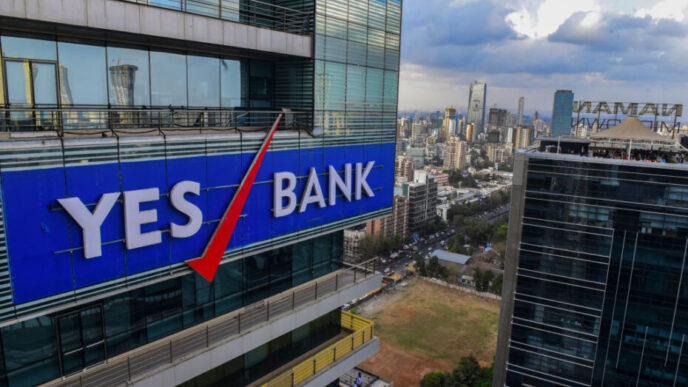As trade restrictions mount across the U.S., Europe, and parts of Asia, Chinese steelmakers are turning their gaze to Saudi Arabia, forging a new export corridor that underscores both the Kingdom’s construction boom and China’s deft recalibration of its global supply strategy.
Shipments of Chinese steel to Saudi Arabia surged 41% in the first nine months of 2025 compared with the same period a year earlier — the sharpest rise to any major export destination, according to Chinese customs data analyzed by Bloomberg. The pivot marks a strategic response to intensifying anti-dumping measures and carbon-related tariffs in Western markets that have squeezed Chinese exports elsewhere.
Saudi Arabia Becomes China’s Bright Spot Amid Trade Pressures
While Chinese steel exports have faced headwinds in Europe, the United States, and parts of Southeast Asia due to protectionist policies and green tariffs, Saudi Arabia’s vast infrastructure drive has created a powerful new demand center.
The Kingdom’s Vision 2030 program, spearheaded by Crown Prince Mohammed bin Salman, aims to diversify the economy beyond oil and transform the country into a global hub for tourism, logistics, and renewable energy. Mega-projects such as NEOM, The Line, and Qiddiya have triggered a construction boom, driving up demand for flat and long steel products, rebar, and specialized high-strength materials.
“Saudi Arabia is now China’s most promising steel export market,” said Chen Qiang, a senior analyst at Mysteel Research Institute in Shanghai. “As the West closes its doors to Chinese metals, Riyadh is opening them wider — not just for cost reasons, but because of its unparalleled scale of development.”
According to customs data, China shipped more than 6.2 million metric tons of steel to Saudi Arabia between January and September 2025, compared with 4.4 million tons in the same period last year.
Trade Curbs Elsewhere Accelerate the Shift
China’s reorientation toward the Middle East comes as the European Union expands its Carbon Border Adjustment Mechanism (CBAM), effectively imposing tariffs on high-emission products like steel, aluminum, and cement. The United States has likewise increased scrutiny of Chinese metal imports under Section 232 and 301 trade measures, while regional partners such as Vietnam and Indonesia have raised anti-dumping duties to protect domestic industries.
“Chinese steel producers are being pushed out of traditional markets by climate tariffs and trade politics,” said Alicia García Herrero, chief economist for Asia Pacific at Natixis. “The Gulf, led by Saudi Arabia, offers both growth and neutrality — it’s a natural redirection point.”
This shift has also been facilitated by improved logistics and energy ties between Beijing and Riyadh. A growing number of Chinese state-linked contractors are now active in Saudi Arabia, from China State Construction Engineering Corporation (CSCEC) to PowerChina, bringing with them procurement chains that favor Chinese steel.
Saudi Arabia’s Construction Surge Creates an Import Boom
At the heart of this growing partnership lies a simple equation: Saudi Arabia is building faster than its domestic steel industry can keep up.
The Kingdom currently consumes over 20 million tons of steel annually, a figure expected to double by 2030, according to data from the Gulf Organization for Industrial Consulting (GOIC). While Saudi producers such as Saudi Iron & Steel Company (Hadeed) and Al Rajhi Steel have expanded capacity, local output remains insufficient to meet massive project timelines.
“The demand curve in Saudi Arabia is almost vertical,” said Mohammed Al Ghamdi, a Riyadh-based construction consultant. “Every week, a new megaproject breaks ground, and timelines are tight. Chinese steel fills that gap quickly and cost-effectively.”
Chinese shipments now account for roughly 40% of Saudi Arabia’s imported steel, displacing traditional suppliers from Turkey, South Korea, and India.
Strategic Alignment: Energy for Infrastructure
The trade relationship is increasingly mutually reinforcing. As China remains one of the largest importers of Saudi crude oil, the Kingdom’s growing imports of Chinese steel and construction materials highlight a reciprocal trade dynamicthat underpins deeper economic cooperation.
“Energy flows east, infrastructure flows west — this is the new trade symbiosis,” said Dr. Lina Khatib, a trade analyst at the Gulf Research Center. “China provides the materials to build Saudi Arabia’s post-oil future, and Saudi oil helps power China’s industrial engine.”
This alignment also dovetails with China’s Belt and Road Initiative (BRI), which has prioritized Gulf partnerships as Western financing retreats. The China-Saudi Comprehensive Strategic Partnership Agreement, signed in 2022, laid the groundwork for joint ventures in metallurgy, logistics, and industrial park development.
Global Implications: Price Pressure and Policy Risks
China’s redirection of steel exports toward Saudi Arabia and other Gulf economies is not without global consequences. The surge has already contributed to price volatility in Asian steel benchmarks, as producers reallocate supply and shipping routes.
Analysts also warn that overreliance on Gulf demand could expose Chinese producers to geopolitical and cyclical risksif Saudi construction slows or global energy prices fluctuate.
“Saudi Arabia is a lucrative market today, but it’s project-driven,” said Mark Tan, metals strategist at DBS Bank. “If project timelines shift or fiscal priorities change, demand could suddenly weaken. Chinese mills are betting heavily on the continuity of Vision 2030.”
At the same time, the inflow of cheaper Chinese steel may pressure regional producers in the Gulf Cooperation Council (GCC), some of whom have lobbied for protective tariffs to safeguard domestic industries.
Sustainability Questions Loom
While Saudi Arabia’s embrace of Chinese steel supports its construction boom, the carbon footprint of imported metals could complicate the Kingdom’s net-zero ambitions. China remains the world’s largest steel producer — and emitter — with most mills still powered by coal.
Riyadh is now encouraging suppliers to adopt low-carbon production technologies, including green hydrogen-based steelmaking, as part of the Saudi Green Initiative. Several Chinese firms have expressed interest in co-developing decarbonized steel plants in the Kingdom to align with these goals.
“Green steel cooperation could become the next phase of the partnership,” said Dr. Xu Liang, an energy transition researcher at Tsinghua University. “It’s an opportunity for both nations to evolve beyond trade into technology collaboration.”
A New Steel Silk Road
China’s pivot toward Saudi Arabia marks a broader reconfiguration of global steel trade — one shaped less by cost competitiveness alone and more by politics, policy, and strategic alignment.
As Western markets tighten trade barriers, the Middle East is emerging as both a customer and collaborator for Chinese industry, extending the Belt and Road network into one of the world’s most ambitious construction frontiers.
“This is not just about exports,” said Herrero. “It’s about influence, presence, and long-term partnership in a region building the cities of the future.”
Conclusion
From skyscrapers in Riyadh to futuristic corridors in NEOM, Chinese steel has become the backbone of Saudi Arabia’s new economic era. The 41% surge in shipments reflects not only shifting trade flows but also a deeper recalibration of globalization itself — one in which Beijing and Riyadh find shared opportunity amid protectionism elsewhere.
As Western markets turn inward, the China–Saudi steel corridor may well define a new chapter in industrial diplomacy — forging an alliance built not on ideology, but on infrastructure, energy, and mutual growth.
















